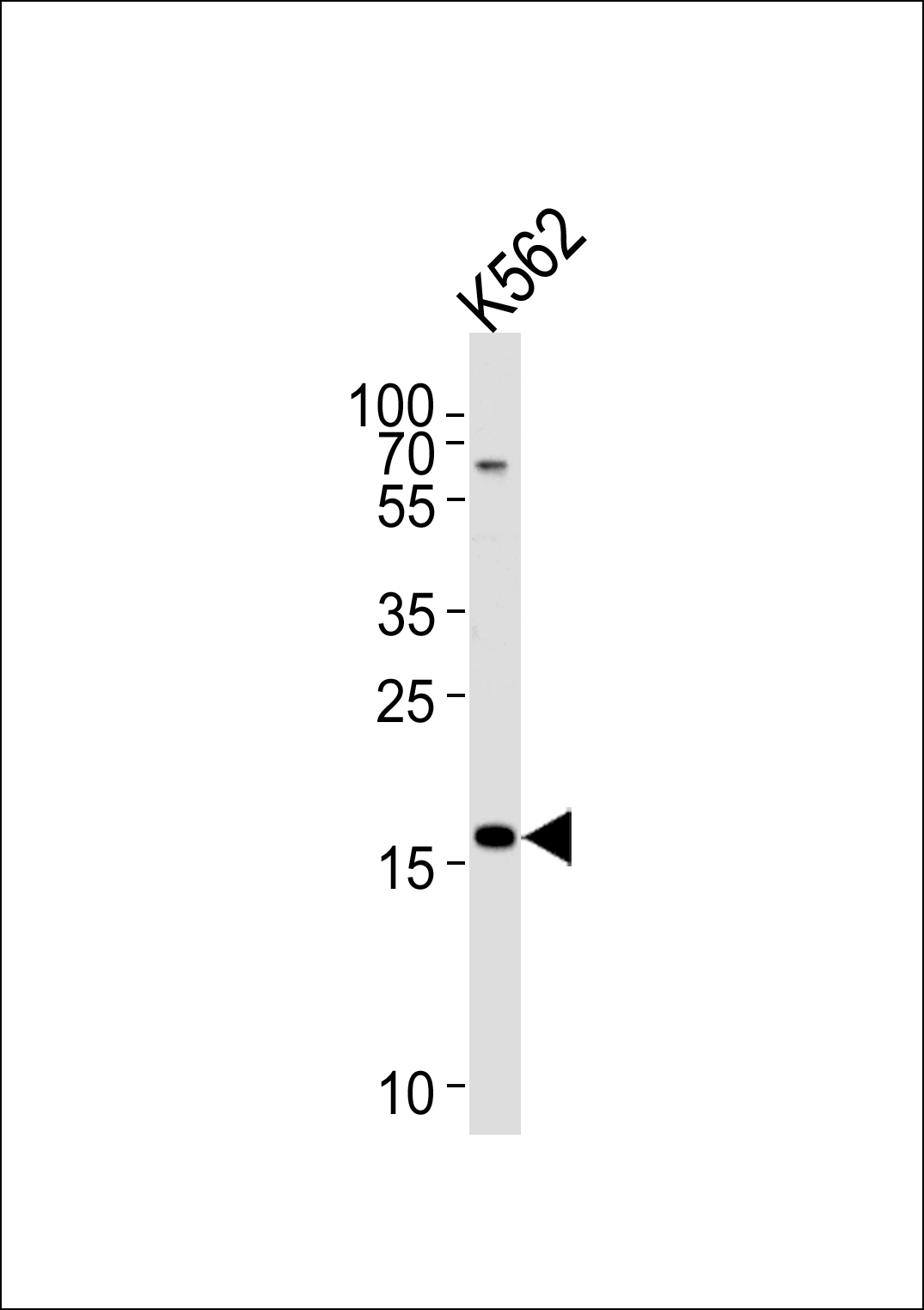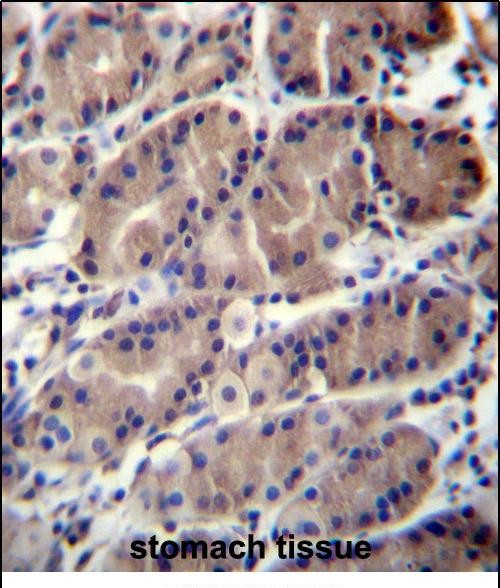RNF5 Antibody (Center)
Affinity Purified Rabbit Polyclonal Antibody (Pab)
- 产品详情
- 文献引用 : 1
- 实验流程
- 背景知识
Application
| IHC-P, WB, E |
|---|---|
| Primary Accession | Q99942 |
| Other Accession | Q5M807, O35445, NP_008844.1 |
| Reactivity | Human |
| Predicted | Mouse, Rat |
| Host | Rabbit |
| Clonality | Polyclonal |
| Isotype | Rabbit IgG |
| Calculated MW | 19881 Da |
| Antigen Region | 65-94 aa |
| Gene ID | 6048 |
|---|---|
| Other Names | E3 ubiquitin-protein ligase RNF5, 632-, Protein G16, RING finger protein 5, Ram1 homolog, HsRma1, RNF5, G16, NG2, RMA1 |
| Target/Specificity | This RNF5 antibody is generated from rabbits immunized with a KLH conjugated synthetic peptide between 65-94 amino acids of human RNF5. |
| Dilution | IHC-P~~1:100~500 WB~~1:1000 E~~Use at an assay dependent concentration. |
| Format | Purified polyclonal antibody supplied in PBS with 0.09% (W/V) sodium azide. This antibody is purified through a protein A column, followed by peptide affinity purification. |
| Storage | Maintain refrigerated at 2-8°C for up to 2 weeks. For long term storage store at -20°C in small aliquots to prevent freeze-thaw cycles. |
| Precautions | RNF5 Antibody (Center) is for research use only and not for use in diagnostic or therapeutic procedures. |
| Name | RNF5 {ECO:0000303|PubMed:9533025, ECO:0000312|HGNC:HGNC:10068} |
|---|---|
| Function | Membrane-bound E3 ubiquitin-protein ligase that mediates ubiquitination of target proteins (PubMed:11329381, PubMed:12861019, PubMed:16176924, PubMed:19269966, PubMed:19285439). May function together with E2 ubiquitin-conjugating enzymes UBE2D1/UBCH5A and UBE2D2/UBC4 (PubMed:11329381). Mediates ubiquitination of PXN/paxillin,thereby regulating cell motility and localization of PXN/paxillin (PubMed:12861019). Catalyzes ubiquitination of Salmonella type III secreted protein sopA (PubMed:16176924). Mediates the 'Lys- 63'-linked polyubiquitination of JKAMP thereby regulating JKAMP function by decreasing its association with components of the proteasome and ERAD; the ubiquitination appears to involve E2 ubiquitin-conjugating enzyme UBE2N (PubMed:19269966). Mediates the 'Lys-48'-linked polyubiquitination of STING1 at 'Lys-150' leading to its proteasomal degradation; the ubiquitination occurs in mitochondria after viral transfection and regulates antiviral responses (PubMed:19285439). Catalyzes ubiquitination and subsequent degradation of ATG4B, thereby inhibiting autophagy (PubMed:23093945). |
| Cellular Location | Cell membrane; Multi-pass membrane protein. Mitochondrion membrane; Multi-pass membrane protein. Endoplasmic reticulum membrane; Multi-pass membrane protein. Note=Predominantly located in the plasma membrane, with some localization occurring within cytoplasmic organelles |
| Tissue Location | Widely expressed.. |
For Research Use Only. Not For Use In Diagnostic Procedures.

Provided below are standard protocols that you may find useful for product applications.
BACKGROUND
The protein encoded by this gene contains a RING finger, which is a motif known to be involved in protein-protein interactions. This protein is a membrane-bound ubiquitin ligase. It can regulate cell motility by targeting paxillin ubiquitination and altering the distribution and localization of paxillin in cytoplasm and cell focal adhesions.
REFERENCES
Barcellos, L.F., et al. PLoS Genet. 5 (10), E1000696 (2009) :
Tcherpakov, M., et al. J. Biol. Chem. 284(18):12099-12109(2009)
Zhong, B., et al. Immunity 30(3):397-407(2009)
McKinnon, E., et al. Diabetes Obes Metab 11 SUPPL 1, 92-100 (2009) :
Bromberg, K.D., et al. Cancer Res. 67(17):8172-8179(2007)
终于等到您。ABCEPTA(百远生物)抗体产品。
点击下方“我要评价 ”按钮提交您的反馈信息,您的反馈和评价是我们最宝贵的财富之一,
我们将在1-3个工作日内处理您的反馈信息。
如有疑问,联系:0512-88856768 tech-china@abcepta.com.






















 癌症的基本特征包括细胞增殖、血管生成、迁移、凋亡逃避机制和细胞永生等。找到癌症发生过程中这些通路的关键标记物和对应的抗体用于检测至关重要。
癌症的基本特征包括细胞增殖、血管生成、迁移、凋亡逃避机制和细胞永生等。找到癌症发生过程中这些通路的关键标记物和对应的抗体用于检测至关重要。 为您推荐一个泛素化位点预测神器——泛素化分析工具,可以为您的蛋白的泛素化位点作出预测和评分。
为您推荐一个泛素化位点预测神器——泛素化分析工具,可以为您的蛋白的泛素化位点作出预测和评分。 细胞自噬受体图形绘图工具为你的蛋白的细胞受体结合位点作出预测和评分,识别结合到自噬通路中的蛋白是非常重要的,便于让我们理解自噬在正常生理、病理过程中的作用,如发育、细胞分化、神经退化性疾病、压力条件下、感染和癌症。
细胞自噬受体图形绘图工具为你的蛋白的细胞受体结合位点作出预测和评分,识别结合到自噬通路中的蛋白是非常重要的,便于让我们理解自噬在正常生理、病理过程中的作用,如发育、细胞分化、神经退化性疾病、压力条件下、感染和癌症。







